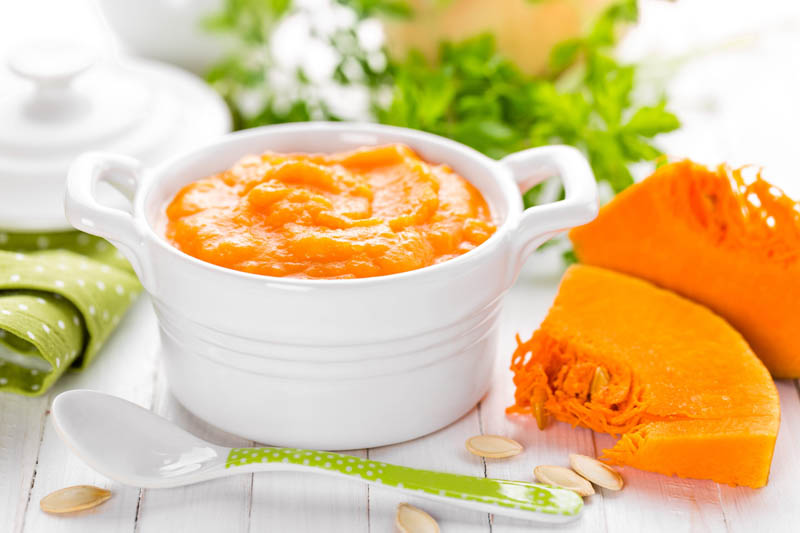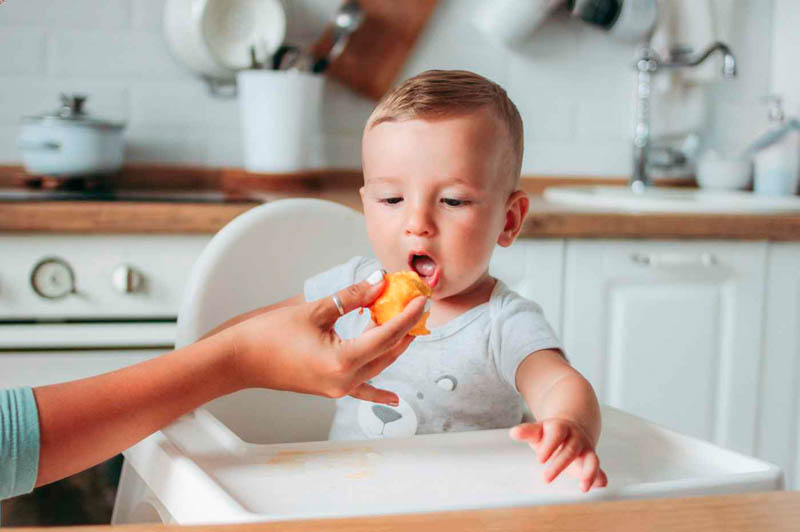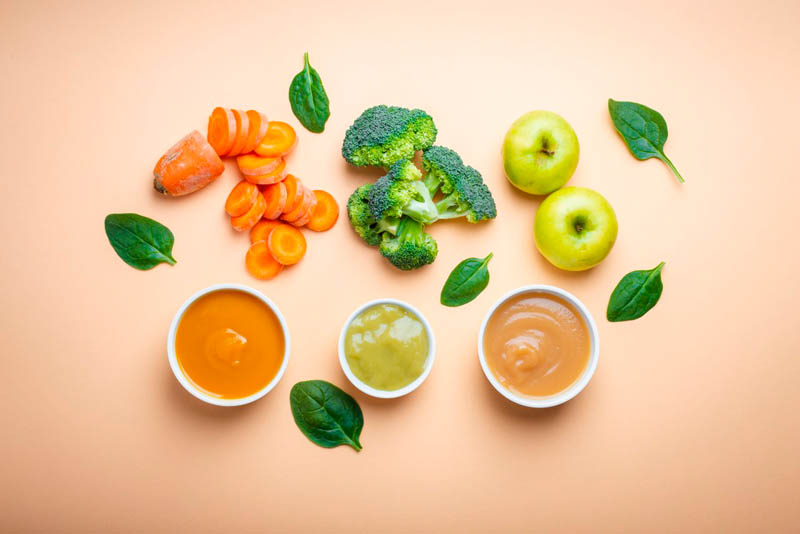Eating solid foods is an important step in your baby’s development even though it may bring a lot of hassle. But it’s definitely worth it. Have you ever thought of how thrilling it is for a baby to discover all the variety of tastes? I’d give anything to try a raspberry for the first time once again! But how to start solid foods?
Support your little kid in exploring something new, regardless of how much food is left on his clothes and all over the room. Remember what a unique experience and priceless joy it is for them!

What Is the Right Time to Start?
As a rule, when parents still wonder how to start solid foods, kids begin eating them when they are already 4-6 months old. However, always remember that it is very individual and depends on many factors. No need to rush your kid if he/she is not ready yet. It is totally okay to feed your baby with breast milk for the first half a year. The digestive tract of a baby may not be ready for solid food yet.
By insisting on solids too soon you may also cause the opposite effect so that your kid can possibly refuse to eat this food in the future. The American Academy of Pediatrics and CDC recommend introducing solid foods no earlier than at age of 6 months.
At the same time, we do not recommend postponing this important step for a long time (till 9 months, for instance), as this may also cause some difficulties in the future. The older a baby is, the harder it is to teach him how to chew and swallow. It actually makes sense because a baby has already got used to liquid and creamy food.
A great lifehack is to give your kid gumming solid pieces that are comfortable to hold in little hands. It will create a certain smooth transition from liquids to solids.
How to Understand It’s Time to Start Solids?
So how to start solid foods exactly? When is the right timing? The best way to make sure that a kid is ready to move on to solids is to ask your pediatrician. However, here are some other signs that can push you to introduce solids to your kid:
- If a kid can hold his head well on his own in a sitting position;
- If a kid can move his tongue up and down, left and right, back and forth, and open his mouth widely enough as for a spoon. You just need to watch him attentively to notice that;
- A baby stopped to thrust solid food particles out of her mouth with his tongue. You can check it yourself by giving him a little piece of food with breast milk and watch the reaction;
- If a kid repeatedly tries to grab something from the dining table during your meal. This means that he is curious about what is located there so that he is more likely to try eating solid food just like adults at the table do.

10 Main Tips on How to Start Solid Foods
We recommend that you stick to the following rules:
#1. Perfect Timing
High time to feed a kid is always strictly individual. In case you give your baby breastmilk, you can feed him with solid food when you do not have much milk. Usually that happens in the evening.
#2. Sit Comfortably
It’s trite but true. After an hour of trying to feed your precious kid, you will get why one shouldn’t underestimate the importance of a comfortable sitting position.
#3. Wait till Your Baby Is in a Good Mood
Naturally, he will interact easily and more willingly when he is joyful rather than hysterical.
#4. Prepare
The most suitable option for such a procedure will be a soft plastic or silicone spoon. You’ll probably need several ones. Do not wonder why, just trust us on this.
#5. No Hurry
At first, you may be astonished by how much time it takes to teach a kid to eat solid food. However, you have no other choice but to keep calm and get used to it.
#6. Introductory Lesson
Before starting feeding, give your kid to examine the food you give him. Let him touch it, play with it, and he will probably try to eat it on his own just out of pure interest.
#7. Show a Good Example
All kids are extremely sensitive to the adults’ behavior, so first of all, you need to show a good example of eating yourself. Then your kid will probably want to repeat after you.
#8. Need to Know When to Stop
Do not overdo not to cause the opposite effect.
#9. Be Ready for a Rebellion
Not all babies are eager to start something new. Some just get fussy because of confusion. Don’t get disappointed so easily.
#10. Forget about Measuring Portions
If most of the food ends up all over the room but not in the little mouth at first, then just compensate with milk for it not to leave your kid hungry. Don’t spare food but treat it like an expendable for the learning process.

The Most Suitable First Food
If you search for recommendations on how to start solid foods, of course, you’ll see that purees are the best option in this case. They are smooth and have some similarities with liquid food. Then, step by step, you can thicken the texture, making it more similar to solid food.
Here we share some ideas with you concerning what solid food to start with:
- Cereal. Blend it with milk or water to reach the texture of a puree. We do not recommend adding any extra food like fruits, etc., at least at first. Let your baby get used to the taste of pure cereal;
- Fruits. Usually, they are kids’ favorites thanks to their sweet taste and bright colors. So you are not likely to have problems with this one;
- Vegetables. Green vegetables are considered to have the strongest taste, so they are not recommended to begin with. It would be better to choose mashed potatoes or carrot puree, etc.
Closer to the age of 9 months, you may definitely try adding other foods, such as:
- Ground meat;
- Cheese and eggs;
- Beans;
- Full-cream milk yogurt;
- Tofu.
It would be better not to mix different foods before your kid tries the pureed taste of it separately.
Pediatricians strongly advise not to feed your kid with honey and cow’s milk during his first year of life. It is explained by the fact that these products have certain bacteria in their composition that may cause severe illnesses in kids.

How to Start Solid Foods? What If There Is a Risk of Allergy?
Previously it was common practice not to give babies certain food to prevent future allergies to these products. However, now it is proven to be wrong, so do not repeat the mistake of our parents.
At the age of about 5 months, you may try to give your kid some allergenic products and that may help to prevent future allergies. Just make sure this is not the first solid food he tried.
Even though kids at such a young age are likely to have allergies, they often disappear by the time a kid turns 5 years old. However, you’d better be careful with that. Do not keep feeding your baby with the same food if you see any slightest symptoms of an allergy. Consult your doctor instead.
How to Avoid Choking
Some parents are extremely afraid that their kids may choke over solid particles when wondering how to start solid foods correctly. To prevent that, stick to the following rules:
- Don’t leave your kid alone with food. All the interactions with solid food (especially the first ones) need to be strictly under parents’ supervision;
- Step by step. Start with the smallest pieces and gradually go on to bigger pieces and bigger amounts of food per meal. However, do not give your baby a full plate of food, a few pieces will be totally enough.
- Feed your kid in the baby seat. Playing with food while running, screaming, and having fun is not a good idea and may cause some unpleasant accidents.
We recommend avoiding tough food, such as nuts and everything containing nuts, popcorn, etc. Some stringy chunks of meat obviously would do no good, too.
Gagging or Choking: When It Is Dangerous
Most parents striving to find out how to start solid foods and make the process 100% safe are scared when their kids start gagging. Surprisingly, the gag reflex is totally okay in case your baby tries new food. It does not indicate any reasons to worry about. But it’s a different matter if he’s choking. How to tell the difference between choking and gagging? A baby will be extremely frightened but quiet. He won’t be breathing, and you’ll see it for sure. Gagging, on the contrary, is loud and is accompanied by coughing.
It all may look a bit challenging at first, but you’ll get used to it quickly. Actually, cooking for a baby is even easier than for someone older – no need to add any spices or salt. Just warm it up a little bit, and that’s it! And don’t forget to start brushing your baby’s teeth!
All the recommendations and tips listed here are based on the information provided by a range of highly respected institutions, among which are the FDA (Food and Drug Administration), CDC (Centers for Disease Control and Prevention), and AAP (the American Academy of Pediatrics).





